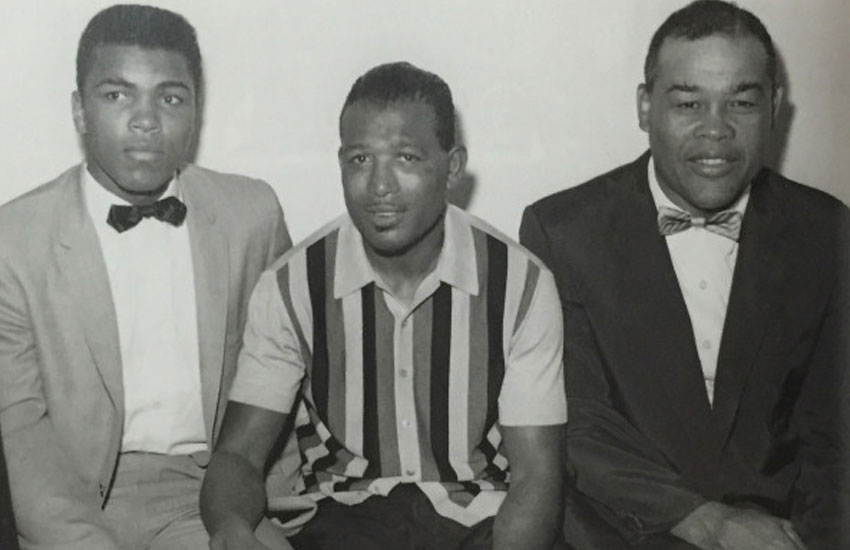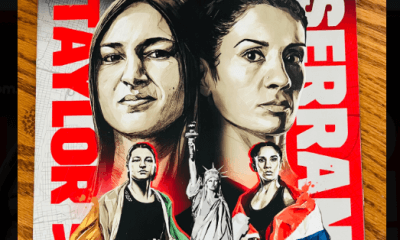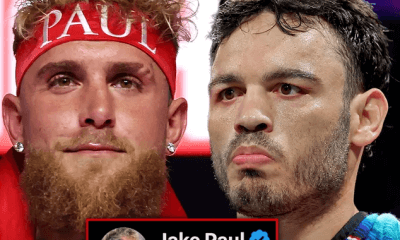Featured Articles
The Four Faces on the Mount Rushmore of Boxing: A New TSS Survey
In this survey we posed a hypothetical question: Suppose that there was going to be a Mount Rushmore of Boxing with the faces of four boxers carved on to a granite mountain

In this survey we posed a hypothetical question: Suppose that there was going to be a Mount Rushmore of Boxing with the faces of four boxers carved on to a granite mountain. Further suppose that a duly authorized panel decided that Joe Louis, Sugar Ray Robinson, and Muhammad Ali would be three of the four, but could not agree on who warranted the fourth slot. Which fighter would you pick?
We posed this question to more than 30 respondents. As the person that ran the survey, I have the honor of going first. I gave the fourth slot to WILLIE PEP. He had an incredible record of 230-11-1 with 65 KOs and is considered one of boxing’s all-time great defensive artists. He turned pro in 1940 and won his first sixty-three fights. After serious injuries suffered in a plane crash in 1947, he came back and continued to win and win and win.
Here are the other picks. The respondents are listed alphabetically.
JIM AMATO, author, writer, collector: As much as I’d like to say my favorite fighter, Roberto Duran, I’ll have to go with HENRY ARMSTRONG. Hank’s accomplishments will never be duplicated.
RUSS ANBER, trainer, cornerman, and owner of Rival Boxing Equipment: You simply cannot add anyone to the Holy Trinity! There is the Father, The Son and The Holy Spirit. These three greats are undisputed. The fourth can never be! No other fighter in history transcended the sport as did these three. Nuff said!
MATT ANDRZEJEWSKI, TSS writer: HARRY GREB. In my opinion, Greb is the best pound for pound fighter of all time. He was known as a punching machine and for throwing punches at all sorts of differing angles that often overwhelmed his opposition. His resume and ring accomplishments speak for themselves. Incredibly, many of his best wins came after he suffered an injury to his right eye that caused vision problems.
JOE BRUNO, former New York City sportswriter; prolific author: ROCKY MARCIANO is the only undefeated heavyweight champion and he fought everyone who was around at the time. I’d have him there even before Ali. And what about Jack Dempsey, who was the leading figure in boxing in the Roaring Twenties, the Golden Age of Boxing? Say what you want about Ali, but he lost five fights, including one to Leon Spinks, who was fighting in only his eighth pro fight.
ANTHONY CARDINALE, former manager of several top fighters including John Ruiz: ROCKY MARCIANO, 49-0, heavyweight champion from Massachusetts. Enough said.
JILL DIAMOND, WBC/NABF supervisor and award-winning voice in female boxing: ROCKY MARCIANO would be my choice. My second would be Floyd. Both undefeated and, depending on your point of view, 49 or 50 wins.
CHARLIE DWYER, retired referee and member of the Marine Boxing Hall of Fame: WILLIE PEP. In his prime he was practically untouchable. A classic boxer personified.
BERNARD FERNANDEZ, journalist; one of only eight lifetime members of the Boxing Writers Association of America: Lots of possibilities and most are worthy of that fourth slot. But upon further reflection, I’m going with HENRY ARMSTRONG.
PEDRO PETE FERNANDEZ, former boxer and manager of Ring Talk: I select ROBERTO DURAN. Hands down.
JEFFREY FREEMAN, aka KO DIGEST, TSS writer: The fourth carved rockhead for the fantasy Mount Rushmore belongs to the immortal “Brockton Blockbuster,” ROCKY MARCIANO, an undefeated heavyweight champion who personified both toughness and sportsmanship. The name “Rocky” is synonymous with boxing like no other (okay, perhaps “Sugar Ray.”) Behold my Fab Four of Sugar Ray Robinson, Joe Louis, Muhammad Ali, and Rocky Marciano.
HENRY HASCUP, historian and long-time President of the New Jersey Boxing Hall of Fame: HENRY ARMSTRONG held three world titles at the same time. Armstrong defended the world welterweight championship a division record 19 times. Armstrong was 27-0 with 26 knockouts in 1937, 14-0 with 10 knockouts in 1938, and 59-1-1 with 51 knockouts from December 1936 to October 1940. Armstrong defeated sixteen world champions.
CLARENCE GEORGE, boxing writer: So many worthies….John L. Sullivan, Jack Dempsey, the absurdly untitled Sam Langford, Harry Greb, second only to Sugar Ray Robinson (and arguably his superior) in what has always been boxing’s richest division; and Henry Armstrong, the first three-division world champion at a time when there were only eight divisions. But I have to go with WILLIE PEP. I can’t help but be in awe of his justifiably legendary record and against a slew of amazing fighters, including the superb Sandy Saddler. What astonishing skill and technique, particularly in terms of defensive wizardry. The greatest featherweight of all time? To be sure. But more, so much more, than that.
IVAN GOLDMAN, author and boxing write: I wracked my brain, but all the names I tried were ultimately indefensible. I know of no fighter to equal the stature of these three men. But I don’t pretend to know everything, and perhaps someone will come up with a name that makes sense. Plenty of quality fighters never got the right fights at the right time.
LEE GROVES, author, writer and Wizard of CompuBox: Very difficult question. I choose HENRY ARMSTRONG because Mount Rushmore is supposed to embody the four greatest in a certain area, and I have him as the second greatest pound-for-pound fighter in history. At his best, there were few better and he holds the unique record of holding three divisional championships simultaneously, which is made much more impressive by the fact he did it during the one champ per division era. He also would be a terrific standard bearer for the smaller weight classes.
BRUCE KIELTY, boxing matchmaker, manager, and historian: JACK DEMPSEY because he represented the era that brought boxing into mainstream acceptance.
STUART KIRSCHENBAUM, former amateur boxer; co-founder of the National Association of Boxing Commissioners: JACK DEMPSEY is my choice. Other boxers have had more impressive records but talking about being enshrined entails social significance. Dempsey, a cultural icon of the 20’s…the golden age of sports, could also be considered the most popular athlete in American history for his media dominance of that era. During his reign from 1919-1926, Dempsey drew boxing’s first million-dollar gate and over 100,000 live for a single fight. He put boxing as the King of Sports.
JIM LAMPLEY, 2015 IBHOF inductee; centerpiece of the HBO broadcasting team: JACK JOHNSON because without him the lives of the other three could have been quite different.
ARNE LANG, author, historian and TSS editor-in-chief: The question becomes whether to choose someone who was indisputably great — someone like Joe Gans or Sugar Ray Leonard — or someone whose greatness is open to question but who transcended the sport. If the latter — and this is the way I lean — the nod goes to JACK DEMPSEY. No athlete was more celebrated during America’s Golden Era of Sports.
RON LIPTON, former fighter, boxing referee, boxing historian, retired police officer: If, in addition to Ali, Robinson and Louis, a recognizable iconic boxing figure should be chosen to be in their illustrious company and that would be JACK DEMPSEY. Only true boxing aficionados would recognize any of the other well deserving boxing legends from all weight classes which we could go on naming for hours.
FRANK LOTIERZO, former boxer, writer, and lead analyst for The Boxing Channel: I would give the open spot to HARRY GREB because he has the deepest and most complete resume and his accomplishments in the ring are more overwhelming than any other fighter I know of. Greb defeated the best quality of opposition and Hall of Fame fighters, often giving away height, reach and weight, more than any other fighter who has yet lived. He defeated 18 men who held, had held, or would hold world championships, and this at a time when there were only eight divisions in boxing and one champion in each division. He was a physical beast with power blended with non-stop aggression. He’s the only fighter to beat Gene Tunney who out-weighed him by 13 pounds. And did all that while being blind in his right eye.
PAUL MAGNO, author, writer and boxing official in Mexico: The logical choice is HENRY ARMSTRONG. He belongs for everything he accomplished and everything he could do. There’s a legit case for placing him number two or number three of all-time and, for me, he’s a no-brainer as the fourth face on boxing’s Mount Rushmore
ADEYINKA MAKINDE, author, boxing writer and UK barrister: I suggest JOE GANS, “The Old Master” himself, who was the first American of African descent to win a world title in the 20th century, thus paving the way for Louis, Robinson and Ali. He was a dominant fighter like they were and also a beloved figure because of his personality and his skills, achieving mainstream acceptance.
GORDON MARINO, philosophy professor, Wall Street Journal boxing writer, and trainer: The “Human Windmill” HARRY GREB. (107-8-3) but surely a lot more fights than that. At 5’8” and a middleweight, he fought and beat most everyone, including Gene Tunney.
DIEGO M. MORILLA, award winning bi-lingual boxing writer from Argentina: HENRY ARMSTRONG. He embodies his era like no one else: the fighter who had to take on all comers on short notice with no preparation and at any weight, and still succeeded in ways that we cannot even imagine today. His numbers are mind-boggling in every sense: his record defenses of the lineal welterweight crown, his fights in four of the original eight divisions with titles in three of them and a dubious draw against the middleweight champ Ceferino Garcia. Willie Pep and Jack Johnson deserve consideration as well, but “Homicide Hank” takes the laurel — and the marble — or whatever that big mountainside is made of.
JOHN RAFUSE SR., former professional boxer: My pick is ROCKY MARCIANO.
FREDERICK ROMANO, author, historian, formerly with HBO: Tough assignment. Henry Armstrong at his peak is a good choice in my opinion as is a prime WILLIE PEP.
LEE SAMUELS, Top Rank publicist emeritus: MARVIN HAGLER was the first star champion we ever worked with at Top Rank. Hagler’s firefight against Hitman Tommy Hearns at Caesars Palace was one of the greatest fights of all time. Hagler in the 80’s was all fighter, one of the greatest in boxing history. He was inducted into the Nevada Boxing Hall of Fame a few years ago and when he went to the podium, he wept and said the Petronelli brothers – Pat and Goody – “were like my fathers who cared for me so much.”
ICEMAN JOHN SCULLY, elite trainer, former title contender, commentator: WILLIE PEP. No question.
PETER SILKOV, writer and manager of The Boxing Glove: I’m torn between Jack Johnson and Henry Armstrong; it’s a shame we can’t choose five! Overall, I choose JACK JOHNSON as his feat of securing his shot at the world heavyweight title is one of the greatest acts of courage and perseverance in the history of boxing, and without him there would have been no Louis or Ali.
MIKE SILVER, author, writer, historian: For me this is a no brainer. The fourth face should be HARRY GREB. His almost superhuman record speaks for itself. He was the ultimate fighter. I didn’t say boxer, for he was not a boxer, at least not in the traditional sense. Harry Greb was a pure fighter whose unorthodox windmill style has never been duplicated. All of the greats he fought spoke of him with awe and considered him their toughest opponent.
BRUCE TRAMPLER, Top Rank matchmaker; 2010 IBHOF inductee. I’d suggest Jack Dempsey who meant so much to the sport as Babe Ruth did for baseball, but I’ll go with the great HENRY ARMSTRONG.
GARY “DIGITAL” WILLIAMS, boxing writer and voice of Beltway Boxing: That’s a tough one but for me, it would be SUGAR RAY LEONARD. He’s a six-time world champion and he, after Ali, was the next boxer to go mainstream as far as commercial endorsements are concerned.
PETER WOOD, 1971 New York City Golden Gloves middleweight finalist and author: JOHN L. SULLIVAN is my choice. This bare-knuckle champion was a hard rock, a badass, and our glorious American Hercules. He could “lick any son-of-a-bitch in the house.”
Observations:
The final tally of votes yielded Henry Armstrong as a narrow winner with a secondary cluster around Dempsey, Greb, Marciano, and Pep following closely behind.
Some went as far back as Jack Johnson and Joe Gans, some went modern with Marvelous Marvin Hagler and Sugar Ray Leonard, and some simply could not come up with a selection that matched the three already on the mountain.
Peter Silkov and Jim Lampley had almost identical responses,
A sincere “Thank You” to all the participants.
Ted Sares is one of the oldest full power (raw modern) lifters in the world and is a four-time winner of the EPF’s Grand Master championship. He also is a member of Ring 4’s Boxing Hall of Fame.
Check out more boxing news on video at The Boxing Channel
-

 Featured Articles4 weeks ago
Featured Articles4 weeks agoAvila Perspective, Chap. 330: Matchroom in New York plus the Latest on Canelo-Crawford
-

 Featured Articles3 weeks ago
Featured Articles3 weeks agoVito Mielnicki Jr Whitewashes Kamil Gardzielik Before the Home Folks in Newark
-

 Featured Articles8 hours ago
Featured Articles8 hours agoResults and Recaps from New York Where Taylor Edged Serrano Once Again
-

 Featured Articles4 weeks ago
Featured Articles4 weeks agoCatching Up with Clay Moyle Who Talks About His Massive Collection of Boxing Books
-

 Featured Articles5 days ago
Featured Articles5 days agoFrom a Sympathetic Figure to a Pariah: The Travails of Julio Cesar Chavez Jr
-

 Featured Articles3 weeks ago
Featured Articles3 weeks agoMore Medals for Hawaii’s Patricio Family at the USA Boxing Summer Festival
-

 Featured Articles7 days ago
Featured Articles7 days agoCatterall vs Eubank Ends Prematurely; Catterall Wins a Technical Decision
-

 Featured Articles4 weeks ago
Featured Articles4 weeks agoRichardson Hitchins Batters and Stops George Kambosos at Madison Square Garden




















